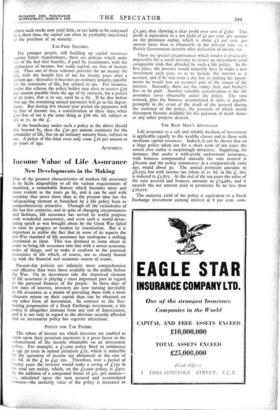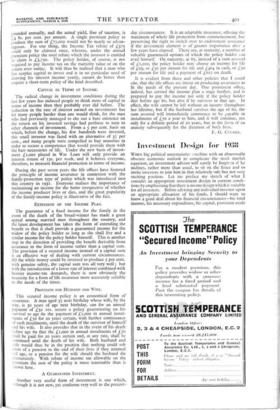Income Value of Life Assurance
New Developments in the Making
ONE of the greatest characteristics of modern life assurance is its facile adaptability to all the various requirements of mankind, a remarkable feature which becomes more and more evident as the years go by, and it can be said with certainty that never more than at the present time has the safeguarding element as furnished by a life policy been so comprehensively attractive. Through all the vicissitudes of the last few centuries, and in spite of changing circumstances and fashions, life assurance has served its useful purpose with wonderful consistency, and even such a world-devas- tating epoch as was brought about by the Great War failed to stem its progress or weaken its constitution. But it is important to reahle the fact that in some of its aspects the pre-War standard of life assurance has undergone a striking revolution in ideas. This was destined to come about in order to bring life assurance into line with a newer economic order of things, and to make it conform to the practical necessities of life which, of course, are so closely bound up with the financial and economic course of events.
Present-day policies are infinitely more comprehensive and effective than were those available to the public before the War. On its investment side the improved element of life assurance is playing a most important part in regard to the personal finances of the people. In these' days of low rates of interest, investors are now turning inevitably to life assurance as a means of providing them with a more adequate return on their capital than can be obtained on any other form of investment. In contrast to the fluc- tuating propensities of a Stock Exchange investment, a life policy is altogether immune from any risk of depreciation, and it is not only in regard to the absolute security afforded that an investment policy has superior attractions.
POINTS FOR TAX PAYERS.
The rebate of income tax which investors are enabled to claim upon their premium payments is a great factor in the enhancement of the income obtainable on an investment policy. For example, a LI,000 policy fixed to commence at age 3o costs in annual premium £52, which is reducible by the operation of income tax abatement at the rate of 2s. 6d. in the £ to £45 los. Therefore, over a period of twenty years the investor would make a saving of £130 in his total net outlay, which, on the Li,000 policy, is £910. By the addition of a compound bonus of 4zs. per annum— e•, calculated upon the sum assured and accumulated bonuses—the maturity value of the policy is increased to £1,490, thus showing a clear profit over cost of £580. This profit is equivalent to a net yield of 41 per cent. per annum on the premium outlay, which is about £2 per cent. per annum more than is obtainable at the present time on a British Government security after deduction of income tax.
There are special circumstances which render it practically impossible for a small investor to secure an investment yield comparable with that afforded by such a life policy. In the first place, the investor would naturally have to make a new investment each year, so as to include the interest as it accrued, and if he was even a day late in making his invest- ments he would lose an essential part of the return of the interest. Secondly, there are the stamp duty and broker's fees to be paid. Another valuable consideration is the life assurance cover obtainable under the policy. The sum assured, plus the bonuses accumulated to date, is payable promptly in the event of the death of the assured during the currency of the policy, the proceeds of which would thereupon become available for the payment of death duties or any other purpose desired.
THE RICH MAN'S ADVANTAGE.
Life assurance as a safe and reliable medium of investment is applicable equally to the wealthy classes and to those with moderate capital resources. Indeed, it can be shown that on a large policy taken out for a short term of ten years the return over outlay is surprisingly attractive. Supposing, for instance, that under a with-profit endowment assurance, with bonuses compounded annually the sum assured is £60,000 and the policy commences at a comparatively early age, round about 3o. The annual premium amounts to £6,25o, but with income tax rebate at 2s. 6d. in the £, this is reduced to £5,875• At the end of the ten years the value of the sum assured and bonuses amounts to £74,980, and it exceeds the net amount paid in premiums by no less than £16,210.
The maturity yield of the policy is equivalent to a Stock Exchange investment earning interest at 8 per cent. com- pounded annually, and the actual yield, free of taxatidn, is Li. 8s. per cent. per annum. A single premium policy to produce the sum of £75,000 would not be nearly so advan- tageous. For one thing, the Income Tax rebate of £375 could only be claimed once, whereas, under the annual premium policy the total reliate which the investor is entitled to claim is £3,75o. The policy holder, of course, is not required to pay income tax on the maturity value or on the return over outlay. It will thus be realised that a man who has surplus capital to invest and is in no particular need of drawing his interest income yearly, cannot do better than acquire a short-term policy of the kind described.
CAPITAL IN TERMS OF INCOME.
The radical change in investment conditions during the last few years has induced people to think more of capital in terms of income than they probably ever did before. The reduction in the rate' of-interest earned on investments has hit many people harder than one would think, for the man who had previously managed to eke out a bare existence on the return on his invested savings had perforce to turn to other channels of investment. From a 5 per cent. basis on which, before the change, his few hundreds were invested, this small investor was faced with an alternative of 3/ per cent., and many people were compelled to buy annuities in order to secure a competence that would provide them with the bare necessaries of life. Under the new basis of invest- ment LI,000 placed in War Loan will only provide an interest return of 13s. per week, and it behoves everyone, therefore, to measure financial protection in terms of income.
During the past seven years the life offices have fostered the principle of income assurance in connexion with the family-protection type of policy which was introduced into this country in 1931. Everyone realises the importance of maintaining an income for the home irrespective of whether the income producer lives or dies, and the great popularity of the family-income policy is illustrative of the fact.
EXTENSION OF THE INCOME PLAN.
The guarantee of a fixed income for the family in the event of the death of the bread-winner has made a great appeal among married men throughout the country, and the latest development has taken the form of extending the benefit so that it shall provide a guaranteed income for the widow of the policy holder as long as she shall live and a similar income for the policy holder himself. This is another step in the direction of providing the benefit derivable from assurance in the form of income rather than a capital sum. The provision of a secured income instead of a capital sum is an effective way of dealing with current circumstances. All the while money could be invested to produce 5 per cent. with genuine safety, the capital sum was all very well ; but with the introduction of a lower rate of interest combined with heavier income-tax demands, there is now obviously the necessity for a form of life assurance more accurately suitable to the needs of the times.
PROVISION FOR HUSBAND AND WIFE.
This secured income policy is an economical form of assurance. A man aged 35 next birthday whose wife, by the way, is 3o years of age next birthday, can for an annual payment of £32 los. secure a policy guaranteeing on his survival to age 6o the payment of £1,000 in annual instal- ments of £so for zo years certain, with further continuance of such instalments, until the death of the survivor of himself,, and his wife. It also provides that in the event of his death' before age 6o that the £1,000 in annual instalments of £50 ,hall be paid for 20 years certain and, at any rate, shall be continued until the death of his wife. Both husband and A-ife would thus be in the position that nothing could rob diem of a pension to the end of their lives if they attained old age, or a pension for the wife should the husband die prematurely. With rebate of income tax allowable on the premium the cost of the policy is more reasonable than is .,hown here.
A GUARANTEED INVESTMENT.
Another very useful form of investment is one which, a?though it is-not new, yet conforms very well to the present- ; day circumstances. It is an adaptable insurance, offering the maximum of whole life protection from commencement, but preserving the right to switch over to endowment assurance if the investment element is of greater importance after a few years have elapsed. There are, at maturity, a number of valuable guaranteed options- of which the policy holder can avail himself. On maturity, at 65, instead of a sum assured of Lt,000, the policy holder may choose an income for life of £93, or £50 per annum for life and £464 in cash, or £50 per annum for life and a payment of £612 on death.
It is evident from these and other policies that I could cite, that the life offices are intent on producing assurances to fit the needs of the present day. One prominent office, indeed, has carried the income plan a stage further, and is prepared to pay the income not only if the policy holder dies before age 6o, but also if he survives to that age. In effect, the wife cannot be left without an income throughout her lifetime, but if the husband survives the age of 6o, the sum assured will immediately commence to be payable in instalments of £50 a year to him, and it will continue, not only for a definite period of 20 years, but in the form of an annuity subsequently for the duration of both lives.
F. G. CULMER.







































































 Previous page
Previous page